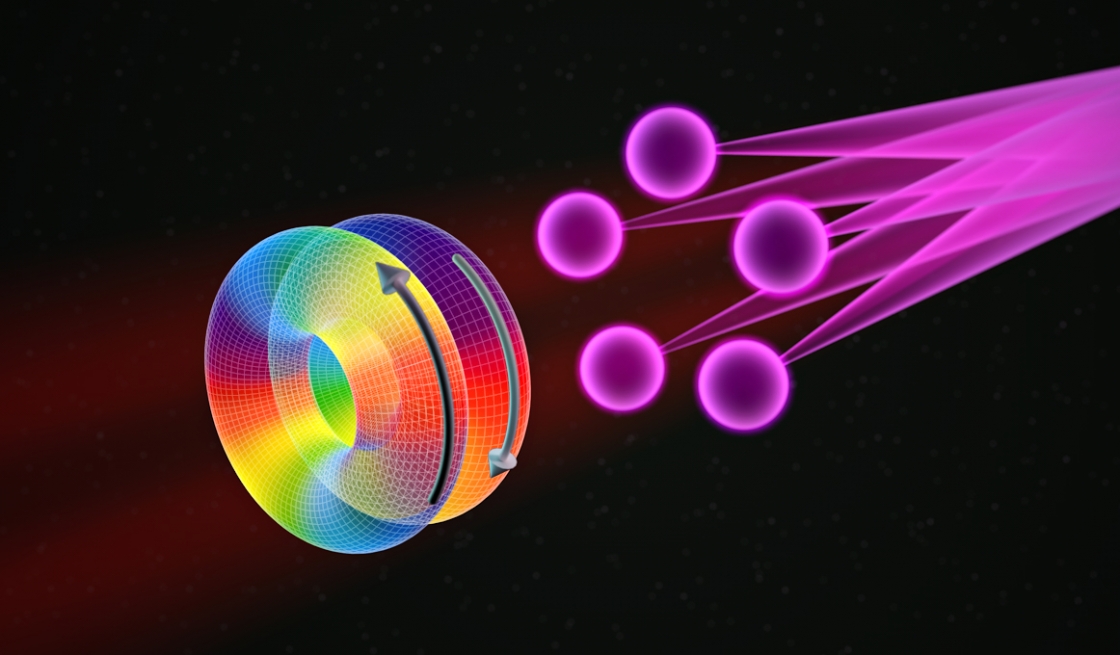Physicists develop some of the most cutting-edge technologies, including new types of lasers, microscopes, and telescopes. Using lasers, physicists can learn more about quantum interactions in materials and molecules by taking snapshots of the fastest processes, and many other things. While lasers have been used for decades, their applications in technology continue to evolve. One such application is to generate and control x-ray laser light sources, which produce much shorter wavelengths than visible light. This is important because progress in developing x-ray lasers with practical applications had essentially stalled for over 50 years. Fortunately, researchers are beginning to change this by using new approaches. In a paper published in Science Advances, a JILA team, including JILA Fellows Margaret Murnane, and Henry Kapteyn, manipulated laser beam shapes to better control properties of x-ray light.
In order to achieve this feat, the team needed a special type of laser beam. According to graduate student Nathan Brooks, working with JILA Fellows Margaret Murnane and Henry Kapteyn: "This work grew out of a long-term collaboration with the group of Carlos Fernandez- Garcia, at the University of Salamanca in Spain. We have previously done a lot of work with them studying doughnut-shaped laser beams carrying orbital angular momentum, or OAM." While OAM may sound complicated, it is merely a component of the dynamic rotation in a light source, and is based on spatial distribution, not the polarization of the light. Using their special OAM laser, the researchers studied the process of high harmonic generation (HHG). HHG works by illuminating a target (usually a gas sample) with an intense femtosecond (10-15 sec) laser pulse. Using HHG, the team projected the OAM laser pulses on argon and helium gas to produce special shapes. Brooks explained: "By imprinting a certain type of structure onto the visible laser, we can transfer some of those properties in a unique and useful way onto the emitted extreme ultraviolet or x-ray light." In manipulating the shape of the beams, the team could change the spectrum (i.e., colors) and divergence (i.e., spreading) of the emitted x-ray beams.
Necklaces and Doughnuts
The first step was to create a necklace-shaped laser beam by combining two distinct OAM laser beams together. Normally OAM laser beams are shaped like donuts. But there's one little twist—if you’ll excuse the pun!—the phase structure is not constant, but rather changes or wraps around the doughnut. “We make the necklace laser beam by interfering two different doughnut laser beams together with different phase structure, and this combination gives that beautiful necklace structure. This in turn allows us to control the properties of the generated x-rays, simply by changing the properties of the necklace," Murnane said. The necklace structure allows for the fine tuning of the color and spectrum of the x-ray beams, which could not be achieved using other approaches.
Being able to change the properties of x-ray beams on demand can have significant consequences. "Widespread applications demands precise control over light," explained Murnane. "Sometimes one needs a focused laser beam, sometimes one needs different colors, polarizations, phases, or shapes. And so, this is one more tool we have available to control x-ray light." Controlling x-ray light can help further research within optics and laser physics. But it also has more real-world applications in spectroscopy or imaging processes. According to Murnane: "It's really only in the last three years that high harmonic generation technology is being adopted for advanced industrial materials R&D applications. Going forward, we can think about tailoring the light, for example, to look at specific structural or magnetic texture." Utilizing this new method, the research team is hoping to probe further into improving the control of x-rays and extreme ultraviolet light. The researchers look forward to the development of these tools for demanding applications in a wide variety of sciences and technology, for example, in bioscience and nanoscience.
Written by Kenna Castleberry, JILA Science Communicator



 The Physics Frontiers Centers (PFC) program supports university-based centers and institutes where the collective efforts of a larger group of individuals can enable transformational advances in the most promising research areas. The program is designed to foster major breakthroughs at the intellectual frontiers of physics by providing needed resources such as combinations of talents, skills, disciplines, and/or specialized infrastructure, not usually available to individual investigators or small groups, in an environment in which the collective efforts of the larger group can be shown to be seminal to promoting significant progress in the science and the education of students. PFCs also include creative, substantive activities aimed at enhancing education, broadening participation of traditionally underrepresented groups, and outreach to the scientific community and general public.
The Physics Frontiers Centers (PFC) program supports university-based centers and institutes where the collective efforts of a larger group of individuals can enable transformational advances in the most promising research areas. The program is designed to foster major breakthroughs at the intellectual frontiers of physics by providing needed resources such as combinations of talents, skills, disciplines, and/or specialized infrastructure, not usually available to individual investigators or small groups, in an environment in which the collective efforts of the larger group can be shown to be seminal to promoting significant progress in the science and the education of students. PFCs also include creative, substantive activities aimed at enhancing education, broadening participation of traditionally underrepresented groups, and outreach to the scientific community and general public.